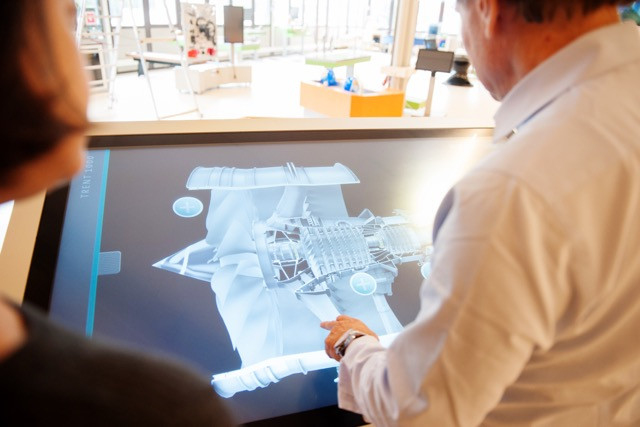The 3,000 m2 space already welcomed around 5,000 students before its official opening, in part because it formerly shared space with the Differdange international school in its nascent stages, but soon the general public will be able to visit the site.
The centre’s president, Nicolas Didier, explains that there was particular interest from the 4.2 cycle, when students start deciding what career they will enter.
“Often those pupils who do not choose to go into sciences will never get a taste for it,” Didier says, “and that is what we are trying to achieve here.”
Robot Fussball
Didier and his team, in fact, looked into around 60 science centres worldwide for inspiration and worked with partners to customise many of the exhibitions. Take, for example, the Fussball table, upon which is fitted an industrial robot provided by Japanese manufacturer Fanuc.
Visitors can challenge themselves against the robot, which is capable of doing 180 cycles per minute. Photo: Lala La Photo
There’s also a a Luxair Embraer jet engine (turbofan) which--when seen in conjunction with the touchscreen model, which allows users to manipulate a digital version of the part to better understand how air is compressed in-flight--helps visitors translate a complicated part to understand it in a simpler, more practical light. (Didier anticipates a virtual reality element later being added to this exhibition).
By 2022-2023, Didier anticipates in a second phase an additional 20,000 m2 of space for the centre in the “architectural marvel” in the adjacent Arcelor Mittal gas power and thermal power plants. With its grand arches and industrial vastness, all it takes is a bit of imagination to envision how the centre could develop into a marvel similar to the Musée d’Orsay in Paris, France.
The phase one centre is functioning through €10 mn in funding, half of which was provided by the Luxembourg government, and it has paid off: the centre will have one of the world’s largest Tesla coils, an electromagnet “of epic proportions”, a fully functional kitchen lab, and plenty of animation to keep even the biggest science cynic “charged” up.
The shocks, scents of science
Didier says in terms of surface area, the centre is split almost 50% exhibits/hands-on activities, 50% workshop space, and efforts are made to have workshops and touchscreens available in five languages: English, French, German, Luxembourgish and Portuguese.
“We’re trying to find a way to bring science and technology to the same, level playing field as sports and music,” says Didier. “We want to entice students and give them opportunities when it comes to professional vocations.”
Scientific director Guillaume Trap--who worked previously at the Palais de la Découverte in Paris--is one such mediator. Trap has a PhD in astrophysics and was formerly a researcher but enjoys being a mediator because “it opens you up to all fields and gives you a bigger picture”.
During Delano’s visit, he demonstrated the basics of electricity through the centre’s Tesla coil, Van de Graaff generator and by putting this Delano journalist in the Faraday cage.
Meanwhile, scientific mediator with a PhD in biology, Nadia Battello, gave a workshop in the fully-equipped kitchen lab, which includes several cooking islands that can be raised or lowered depending on the height of participants. Her workshop reveals why crystals form in common foods like ice cream and chocolate. She also demonstrates the Maillard reaction--which occurs when foods are browned as a result of interaction between reducing sugars and amino acids. It’s the same reaction that occurs through steaks searing and cacao roasting. Battello puts it best: “You can smell chemistry at work.”
Starting 5 October, visiting hours to the Luxembourg Science Center are Monday through Friday, 9am-5pm, and Saturday and Sunday, 10am-6pm.

